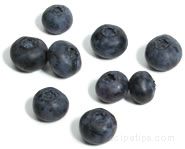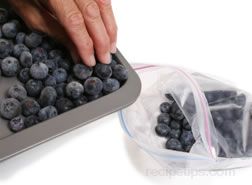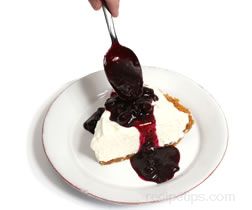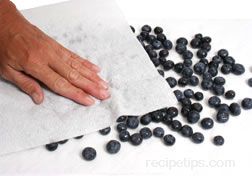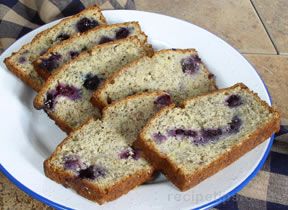| Blueberries | |
|
A small, round, dark blue skinned berry native to North America. They are grown mostly in Northern United States and Canada. Some can be found grown in Northern Europe and Australia. There are many varieties of blueberries that differ slightly in size and taste. They are grown mostly on low bushes but some of the blueberry bushes grow to be 6 to 7 feet tall. The berries are dark blue in color and have a smooth outer skin that has a very thin, silver waxy coating that is called bloom. They have a sweet taste and contain soft seeds that do not need to be removed before eating the berries. Blueberries are commercially cultivated to satisfy demand but the best blueberries are the wild berries you pick yourself. Cultivated blueberries are 2 to 3 times larger than wild blueberries but are not as flavorful. They are in season from late spring to early fall. | |
|
Uses: The berries can be eaten raw, but are also added to fruit salads, pancakes, waffles, muffins, cakes, breads, pies, ice cream, and yogurt or cooked in various desserts. They are also cooked up to make thick sweet toppings for desserts, such as crêpes and cheesecake. Blueberries can also be cooked with sugar syrup to produce jams and jellies. | |
| At Their Best:
Fresh blueberries are most readily available starting in mid April and are available into late September or October. The first of the blueberries begin in the southern states and availability moves north as the weather warms through the season. | |
|
How to Buy: Look for berries that have the silvery bloom coating, are plump and uniform in size, and are not shriveled. If the blueberries do not have the bloom coating, it is an indication that they are not fresh or that they have been washed. Washed berries will not keep as long as unwashed berries. The blueberries should be deep-purple blue to almost a bluish black color. If they have a reddish color to them, they are not ripe yet, but can still be used if they are going to be cooked. Check the bottom of the blueberry container for mold and look for blue stains from the berries. Berries should be firm, dry, and move freely in the container. The blue stains may be from crushed or overripe berries. When buying frozen berries, be sure they are separated and loose in the bag. If they are frozen into a clump, it is a sign that they have at least partially thawed and then been refrozen. | |
| Storage:
Store unwashed blueberries in the refrigerator for a week to 10 days. Be sure to remove any damaged or moldy berries so that they do not contaminate the others. Blueberries can be frozen or canned for storage. Do not wash fresh or frozen blueberries until ready to use. See below for instructions on freezing blueberries. | |
|
Nutrition: | |
| Varieties: | |
|
Wild Blueberries
|
A lowbush variety of blueberries that grows on a bushlike shrub that generally ranges from 1 to 3 feet in height. The berries grow in bunches of 3 or 4 and are quite small in comparison to the cultivated varieties, but the wild blueberries are more flavorful. They are deep-purple blue to almost a bluish black color with a light silvery coating called "bloom," which is a sign of freshness. It is much harder to find wild blueberries and they are usually only sold in local markets when they are in season. They are grown in Canada and throughout the United States wherever there is acidic soil and sufficient moisture, and when the climate is cool. |
|
Cultivated Blueberries
|
Cultivated blueberries are grown to satisfy the demand for blueberries and are the type that are generally available in food stores. They are 2 to 3 times larger than wild blueberries but do not have as an intense flavor. There are two types, which are highbrush and rabbiteye. The shrubs for the cultivated blueberries can grow to be more than 10 feet tall if not cut back. Cultivated blueberries are deep blue in color and have the same white bloom as the wild blueberries. |
|
Dried Blueberries
|
Blueberries that have had the majority of their moisture removed through some method of dehydration. Blueberries are dried using the methods shown below:
Dried blueberries have a concentrated flavor and chewy texture, making them a great snack. They can also be added to baked goods, salads, and cereal. They are available in specialty markets but as their popularity grows availability will increase. |
Processed Blueberries |
When fresh blueberries are not available, there are products that can be used in their place. Frozen berries are available in the freezer area of the food stores, canned blueberries can be drained and add to other foods, and blueberries in a sauce are available for pies and other desserts. |
Loading
All About Blueberries

Provided By
RecipeTips
RecipeTips

Loading
There currently aren't any reviews or comments for this article. Be the first!
Advertisement
Advertisement





